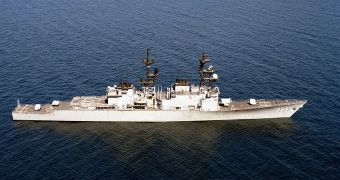The US Navy announces the first successful trip of its algae-biofuel powered destroyer ship, that succeeded in reaching its destination, after a 20-hour trip.
This is a major achievement since representatives behind this project say the innovative kind of biofuel can efficiently replace the fossil fuel usage, reports the Navy Times.
Paul F. Foster, a Spruance-class destroyer, was powered by 20,000 gallons of algae-derived fuel, a much more eco-friendly source of power than its traditional alternative.
After Paul F. Foster, the decommissioned destroyer proved its utility by arriving in Port Hueneme, California, representatives from the US Navy state the vessel will be used for experimental purposes, in the near future.
The successful trial is part of a more ambitious plan. Navy Secretary Ray Mabus declares that the US Navy is going to invest a significant amount of money to support the construction and maintenance of an entire fleet of greener ships, entitled “the Great Green Fleet,” by 2016.
Also, the Navy Times reports that the naval warfare service intends to launch and operate similar destroyers, aircrafts and submarines relying on several eco-conscious substitutes for traditional fuels, including nuclear power.
The same source highlights algae-biofuel, manufactured 50% out of petroleum and 50% out of refined algae oil is as efficient as its dirtier yet more popular rival at this point in time.
The Naval Sea Systems Command reveals the new kind of fuel implemented is obtained out of hydro-processed algal oil and F-76 petroleum.
The choice is definitely in favor of the environment, since officials from the US Navy state that Paul F. Foster running on green algae-derived biofuel triggers a significantly lower amount of CO2 emissions.
This achievement was possible due to the contribution of Solazyme Inc that also provided eco-friendly biofuel powering some of the United Airlines' latest flights.
Until now, a few different aircrafts have already tested the efficiency of alternative fuels, like “F/A-18 Super Hornet and the F-15 Eagle jet fighters, a T-45C Goshawk training jet, an EA-6B Prowler electronic warfare aircraft, an MV-22 Osprey tilt-rotor, an MH-60S Seahawk helicopter and an MQ-8B Fire Scout unmanned helicopter,” according to the Navy Times.

 14 DAY TRIAL //
14 DAY TRIAL //